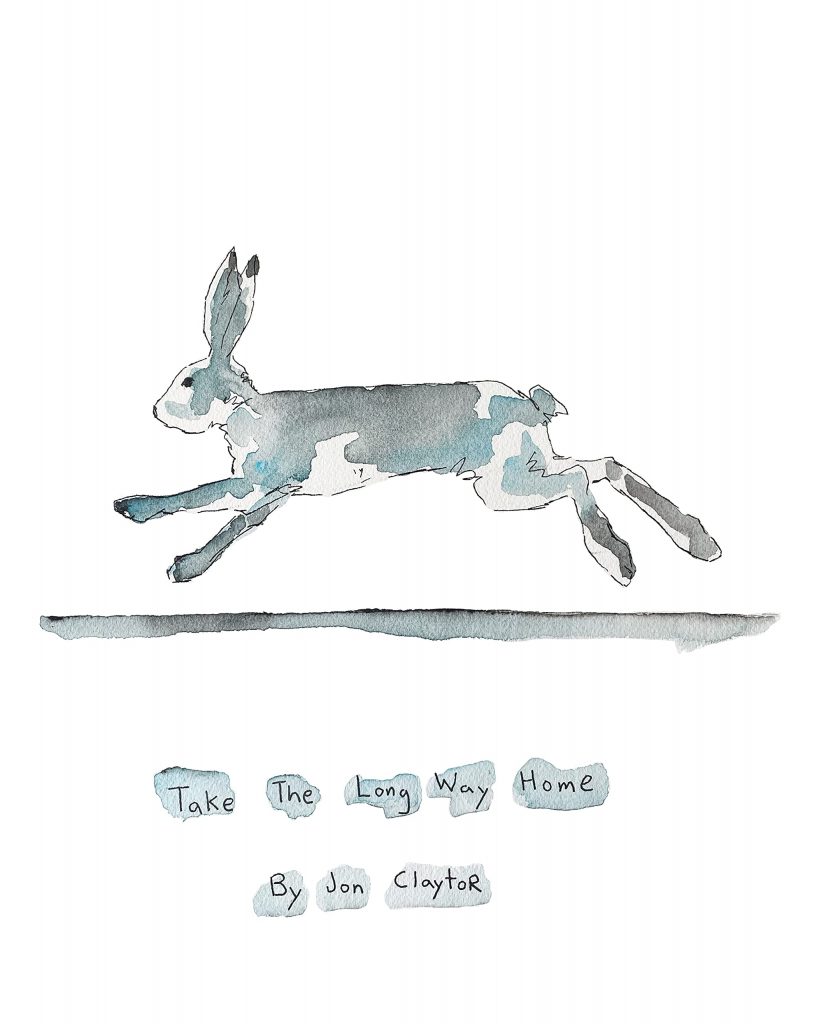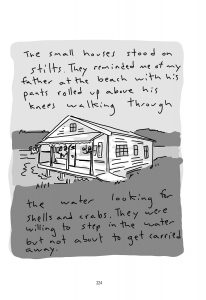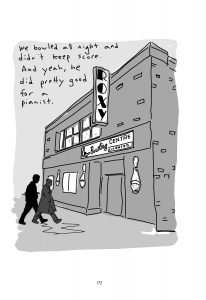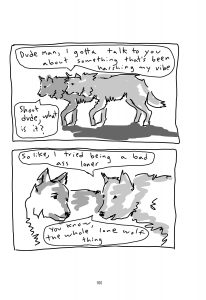Take The Long Way Home | Jon Claytor
An essay by Virgil Hammock

Take The Long Way Home | Jon Claytor
Conundrum Press, Wolfville NS, Canada, 2022, 456pg. pb. $25.00.
Take The Long Way Home is a graphic novel by artist Jon Claytor based on a 2019 voyage of discovery he made from Halifax, Nova Scotia to Prince Rupert, British Columbia. The Sackville based multimedia artist is best known as a painter, but he is equally talented as an illustrator and story teller (as is demonstrated in Take The Long Way Home). His home is now, believe it or not, four doors down from my house in Sackville. Formerly a student of mine at Mount Allison University, he graduated in 1988, and went on to obtain an MFA in painting at York University in 2012.
Between Mount Allison and now Jon has certainly led a full life: perhaps, in comparison to most people, too full of a life. He has just turned fifty and is the father of five children: while trying to make a living as an artist, he has done many other things including bartending at his own bar in Sackville. Actually, in considering my many students over the years, Jon has been a very successful artist with numerous painting exhibitions in Toronto and many sales to his credit. Of course, all of that does not mean making a lot of money – a ‘successful’ artist in Canada does not equate to making a living. However this book – his first – tells another more complex and intimate story of his life. In particular, Take The Long Way Home tells the story of his battle with alcoholism.
Jon was offered a residency in 2019 in Prince Rupert to create this graphic novel. The book is not just about his physical journey from the Maritimes to British Columbia nor solely a consideration of his life as an artist, but is also centered on his human failings and eventual triumph over his personal demons. It was a long drive that resulted in a long book of some 456 pages, a length which even surprised Jon, but there was a great deal to recount.
There was a time in my own life when I took long cross country drives, but that was a long time ago. They were, like Jon’s journey, a time for reflection as the kilometres added up. What is there to do except listen to the radio, try to stay awake and avoid running into something or someone? I often ended up talking to myself (which was generally a dull conversation). Jon’s meditations on this trip – his inter-conversations, when his thoughts and memories were his sole company – were anything but dull.
A good graphic novel’s message, to reverse Marshall McLuhan’s dictum, needs to be more than the medium. The story is the thing. Jon offers a narrative that you don’tt want to put down until you get to the last page. I started it one evening and finished at 3 AM the next morning.
But – as I mentioned earlier – I’m not an ‘average reader’: Claytor’s characters, settings and some events are as familiar to me as Sackville, where myself and my former student live a few houses apart. All of that being said, there is much in this book that’s new to me and gave me a greater understanding of Jon. Take The Long Way Home is not a work of fiction. It’s a visual biography of an important turning point in this artist’s life.
It is the conversations that we have in our minds with ourselves that are the most truthful as regards our successes and failures. The ability to share these conversations, in particular our failures, sets apart an artist like Jon from most people that like to keep their private thoughts to themselves. Jon is often brutal recalling his struggle with alcoholism and how it affected him and those he loves. There is little self pity in his story and he takes full responsibility for his life and actions. But Take The Long Way Home is not a depressing read. There are many moments of humour – and, of course, in the graphic novel format, illustration and drawing are essential elements that shape the reader’s experience. Claytor is an excellent draftsman.
Jon has always had a special talent for drawing animals, and there are many of them in this novel—dogs, wolves, bears, rabbits, horses, and ducks. He gives them a voice in their thoughts and in the conservations that he has with them, rather like Dr. Dolittle showing empathy with the animals. He even illustrated a long thoughtful conversation in Wawa, Ontario, he had with the late Canadian pianist, Glen Gould, that ended in a round of bowling. It turns out that Gould in life liked to stay in Wawa and (according to Jon) still enjoys the town as a ghost. As for Gould’s bowling, Claytor (who once owned a bowling alley and bar in Sackville) was complimentary : “And yeah, he did pretty good for a pianist.”
I asked Jon about the execution of the drawings (all black and white) assuming that he’d done them in sketchbooks; but almost all of them were created on an iPad. That surprised me as I thought that he was more of a traditionalist (I’ve tried unsuccessfully to draw on an iPad, but can’t get past the lack of feedback from the pad’s surface). Claytor’s drawings certainly have the aesthetic of pen and ink (and it’s the results that count and not the medium). He did tell me, however, that he remembered me teaching him about the importance of feedback from a surface, be it a pencil on paper, or a brush on canvas. It is nice to know that former students sometimes remember what you told them, even as they go their own way.
Of course, it is his real conversations with family, close friends, and his inner thoughts that make up the bulk of Take The Long Way Home. He is a man who loves and is loved in return.
It is difficult to honestly come to terms with your own life – much less illustrate it for others to see. Jon has succeeded in doing that. Claytor was told, when he reached Prince Rupert, that “You will know you’re here when the road ends.” His response: “Of course the end of the road isn’t the end of the road.” Take The Long Way Home is the just the beginning.
© Virgil Hammock, Sackville NB, Canada, 16 July 2022.
Essayist

Virgil Hammock was born in Long Beach California in 1938. A Canadian citizen since 1973, He studied at the San Francisco Art Institute where a graduated with a BFA in 1965 after serving as a photographer in the US Army. He then studied at the Indiana University where he obtained a M.F.A in 1967. Appointed as instructor at the University of Alberta Department of Fine arts in 1967, he immigrated to Canada. From 1968 to 1970, he was Assistant Professor of Art, also acting as Director of University of Alberta Art Gallery and Museum. He moved to Winnipeg, where he was appointed Associate Professor of Art at the University of Manitoba from 1970−75 while being in charge also of the University Gallery 1.1.1, as Director of Exhibitions, from 1970−73. In 1975, he moved to Sackville, New Brunswick as Professor of Fine Arts and Head of the Department of Fine Arts at Mount Allison University where he taught until 2004. He also was the acting Director of the University Owens Art Gallery between 1988 and 89.The University nominated him Professor Emeritus of Fine Arts in 2005. Deeply involved in his community, Virgil has been a member of New Brunswick Arts Board, 1996−2002 and of New Brunswick Foundation for the Arts in 1999. Virgil Hammock was President of the Universities Art Association of Canada between 1973−79.
Virgil has also been also fully involved in an art criticism since 1968 when he became the art critic for the Edmonton Journal. He is the author and co author of several art books and artist monographs, including co-author 16 Quebec Painters in their Milieu 1978; Pol Mara 1990; Herman Muys en Monique Maylart 1992; Jacky DeMaeyer 1993; Edward Leibovitz 1994; vgPaul Smolder 1994; Juan Kiti 1995; Cesar Bailleux 1996; Daisy Wilford 1997; Guy Van den Bulcke 1997; Silvain 1997; Hélèn Jacubowicz 1998; Marijan Kolesar 1999; Guy Van den Bulcke: His Presence in the United States 2003. He also published numerous articles in Canadian and international journals and magazines, particularly art magazines. He was member of the editorial board of. Vie des Art (1973−80); Artfocus 1990−2011 and Artsatlantic 1999−2004. A member of AICA Canada, the Canadian Section of the International Association of Art Critics since 1973, Virgil Hammock has been a member of its board from 1975 to present and was he was twice elected its President, between 1976−80 and 1987−91. He was also Vice-President of AICA International board between 1987 and 90.
He is currently Adjunct Curator at the Beaverbrook Art Gallery in Fredericton, New Brunswick. He curated for the gallery: Art Treasures of New Brunswick (21 Feb. to 26 May 2013), Stephen Paints a Picture (27 Feb. to 8 June 2014) and was a co-curator on Off The Grid (26 June to 14 Sept. 2014).Recent publications include The Circle Completed in Redeemed: Restoring the Lost Free Ross Mural, UNB Art Centre, University of New Brunswick (2013) and In Plain Sight, Off the Grid, Beaverbrook Art Gallery (2014). He is, since 1973, the Atlantic provinces correspondent for Vie des Arts where he publishes regularly. Published articles and commentary can be found at vigilhammock.com.
Virgil is a co-founder of the COVERT Collective.
~ Posted by Mark Walton


